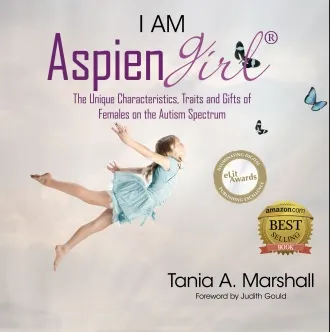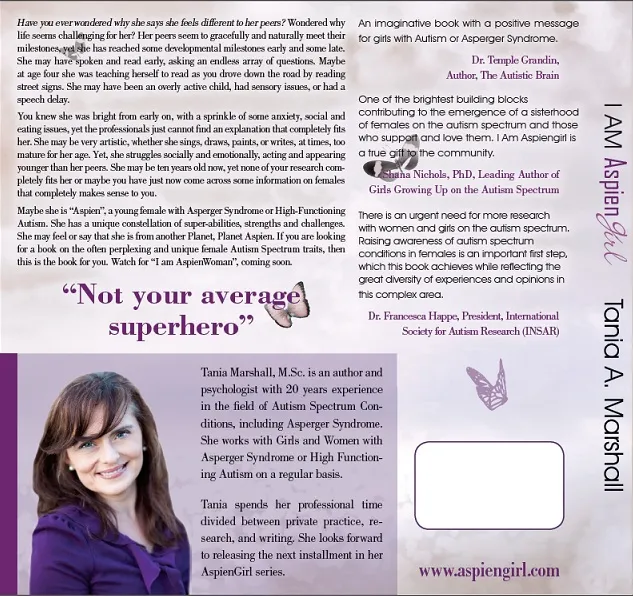Moving Towards A Female Profile: The Unique Characteristics, Abilities and Talents of Young Girls and Teenagers with Asperger Syndrome or Autism


The following list is an official screening document consisting of the unique characteristics and traits of young girls and teenagers with Asperger Syndrome, or High Functioning Autism. This list comes from the many young females I have worked with over the years and currently work with. I have assessed, observed, diagnosed and worked with thousands of girls and women of all ages. This document is based on my clinical anecdotal evidence and research by other well-known professionals. I will be modifying and/or updating this list from time to time. This list was written from my reflections, observations and experience, and is written in no particular order. No-one person needs to have every trait, and it is rare that a person would identify with every trait. ***This list is not a research-based female profile. It is an official descriptive clinical profile, much like the early day descriptions that Asperger, Kanner and Frankl described of the boys they observed. Please be mindful that research often lags behind anecdotal, observational and clinical work. Updated September 8th, 2021
The following profile was created for children, teens and family members or health professionals and researchers who are considering a formal diagnosis and to assist mental health professionals in recognising Asperger Syndrome or Autism in young females. Please be mindful that he current statistics are 3:1 to 2:1 for males to females. I personally believe it is more likely to be 1:1 and that the research will find this in the future.
Females with Asperger Syndrome/Autism/ESSENCE experience their symptoms in varying levels, so while some Aspiengirls are highly introverted, others are not. Females with Asperger Syndrome or Autism tend to be discriminated due to the wide spectrum of abilities or levels of functioning that exists. The majority of females do not receive a formal diagnosis until teenagers or well into their adult years. This list typifies many of the girls and teens I have worked with. This document is based on my clinical anecdotal evidence and research by other well-known professionals. My clinical work is discussed in my award winning books I am AspienGirl here and I am AspienWoman here
I will be modifying and/or updating this list from time to time. This is current as of September 8th, 2021. This list describes females who may be described as twice, have Aspergers. Not all Autistic people are gifted. A significant proportion of Autistic people are Intellectually Impaired (II). Giftedness refers to scoring in the 98% on an IQ test and also having significant Talents. Twice Exceptionally refers to those who are GT and Aspergers/Autistic/ADHD/ESSENCE
- 1. Natural born leaders, seen by girls who are strong willed, often very serious, intense, independent, “My Way” and/or stubborn and bossy
- 2. Intelligence. Bright with an Intense and insatiable curiosity about the world, people, how things work, what people are doing. May be seen in the persistent asking of questions. Usually high average to genius level, uneven profile of abilities. This is knows as “twice-exceptionality”
- 3. Intense emotions and mood swings
- 4. Highly Sensitive and sensory issues (visual, hearing, smell, touch, balance and movement, intuition). A feeling of being different to their peers.
- 5. Social skills differences, which may be displayed in a variety of ways that vary from their same-age peers. For e.g., may be shy in social situations, have one best friend or be a floater (floats from one group to another and having superficial connections with others). A less developed or little understanding of facial expressions, social context, non-verbal body language, theory of mind.
- 6. Self-taught. The ability to teach themselves or learn about anything they are interested in. A preference to direct their learning, rather than teacher-directed learning.
- 7. A high sense of justice and fairness (empathy for the “underdog”) and adherence to rules about how the world and people should operate and/or behave
- 8. Perfectionistic and high standards towards self and others
- 9. Anxiety and/or fears, including negative all-or-nothing thinking and/or Obsessive Compulsive Disorder or obsessive tendencies.
- 10. Gifts or Talents, which may include but are not limited to singing (perfect pitch) and/or music, writing, reading, artistic creations, languages, self-taught, fast learner or other talent(s)
- 11. Fine and/or gross motor difficulties, clumsiness, a lack of co-ordination
- 12. Difficulties understanding the human social hierarchy, age groups and roles within a group, family
- 13. Sleep issues (difficulty getting to sleep due to thinking too much and/or worrying about events that happened that day or what may or may not happen the next day), often not a morning person, tend to prefer staying up later at night
- 14. Stomach issues (cramping, bloating, diarrhoea, constipation, gas) are quite common, due to gluten, wheat and/or casein allergies/intolerances
- 15. Hyperfocus. May not respond to their name being called due to being fully engaged in thought or an activity
- 16. Hyperempathy, emotionally empathic and very caring (for e.g., may lead to bringing home stray or injured animals) but difficulty with cognitive empathy
- 17. Intense love and/or interest in animals, nature, celebrities, fiction, art, mathematics, languages and/or other cultures. May be obsessed with a person, real or fiction, in an unhealthy manner. Other common special or obsessive interests may include but are not limited to: philosophy, psychology, history (for example, Ancient Egypt or Rome, hieroglyphics), languages, Wicca, Vampires, Occultism, psychological profiling and/or criminology/serial killers/detective/FBI/forensic psychologist, science/space/NASA/Stephen Hawking, technology and programming, physical appearance (for example, Gothic, ultra-feminine, tomboy), fantasy, English literature, Law, make-up artistry, art, acting).
- 18. Usually stand out as different from her peers, in terms of her dress (some girls are ultra princess-like in their clothing choices while others prefer to wear more comfortable and functional clothing, yet other stand out as anti-conformist
- 19. Facial expressions may not match the situation or her mood (for example, smiling or laughing in a serious situation)
- 20. May have interests that are mature/advanced AND/OR immature for her age (for example, a young child’s interest in english literature, opera or creative writing
- 21. May be advanced in reading ability OR have trouble with reading comprehension
- 22. May be advanced with mathematics/numbers OR have difficulties (dyscalculia)
- 23. May have Irlen Syndrome
- 24. May have Dyslexia
- 25. May have Auditory Processing Disorder
- 26. May have attention/focusing/impulsivity/hyperactivity issues (see Dr. Daniel Amen’s 7 types of ADD/ADHD at http://www.amenclinics.com/conditions/adhd-add). Usually have the anxious ADD type
- 27. In social situations, she may be shy, quiet, even mute at times OR loud, very verbal and/or aggressive, imposing on other’s boundaries
- 28. Has difficulty with asking for help when needed, saying “no” or asserting her own personal boundaries
- 29. As mentioned previously, she may have trouble with her own boundaries, in addition to the boundaries of others
- 30. May be naive, vulnerable and have a tendency to be taken advantage of. Often confused socially, saying she knows what to do in a social situation when she really does not. Girls appear to be better than boys at masking the traits of autism in social situations. However, girls are less able to do so in unfamiliar settings.
- 31. May bring home stray animals, homeless friends or homeless strangers, much to their parents chagrin

32. May avoid demands that cause her anxiety (Pathological Demand Avoidance, see http://www.thepdaresource.com/)
33. Usually has a low frustration tolerance
34. May have a different voice, for example, younger than her age, talks “babyish” for her age at times, speaks in an accent or in a monotone voice.
35. Avoids complying with requests from adults and may have difficulty with authority figures
36. May be clingy with one or two friends and has trouble sharing her friends with other children
37. “I DON’T KNOW HOW TO BE”. Gender Non Conformity (GNC) and Identity. GNC is not a new thing. In the 80’s there were ‘gender bending’ artists. In every generation, there have been ‘gender-benders’ who were anti-patriarchy and anti-matriarchy ‘out of the box thinkers’. They may be tomboys one day and a fashion diva or a princess the next day. They may be both on the same day. They may spend months vacillating between the two or variations of these presentations. Some may or may not be interested in looking feminine. For those pre-pubertal and going through puberty, this is the highest vulnerability time for mental health issues, being taken advantage of and safety issues. In my clinic, I have worked with thousands of teenagers who, before the transgender trend, the explanation that they must be ‘gender dysphoric’, ‘trans’ or non-binary, I (and other professionals) spend a great deal of time energy and work assisting Autistic teenagers with identity, core self issues, self-esteem, self-talk, social skills, boundaries, asserting themselves, GNC issues, eating disorders, depressions attacks, trauma, sexual abuse, child abuse, bullying, ADHD, depression, anxiety, immaturity, social and communication skills restricted and obsessive unhealthy interests, language skills and sensory processing/fine and gross motor issues. Autistic girls/teens/adults who remain undiagnosed have little idea of who they are and exist in others people world and dont know they are doing that. This is for a variety of reasons and I am currently writing a book about my experiences with my clients as a psychologist operating an Autism Clinic. Many have no awareness and their issues are never resolved until they receive their diagnosis and treatment.
There remain serious ethical and moral safeguarding issues in relation to transgendering Autistic and Aspergic girls and teens. Some of them I briefly outline below:
The Autistic Brain and the core features of Autism (social-communication, sensory processing, fine and gross motor skills issues, restricted interests and speech and language issues/comprehension) and common co-existing conditions (ADHD, anxiety, depression, eating disorders, trauma, etc.). One area of the Autistic brain consists of enlarged Amygdala’s (emotion centers of the brain) and enlarged hippocampus. Puberty is described as “hell” by my teenagers. In 2018, Sir Simon Baron Cohen conducted some fantastic research on the effects of puberty, menstruation and medical conditions including PCOS that affect Autistic women. You may find that here:
The Immature Prefrontal Cortex. It is known that children and teens do not become mature until at least age 25. What this mean is they do not have mature skills in planning ahead, time management, Organization, making decisions, remembering things, considering the consequences of their actions, time management, staying on-task, completing tasks, being responsible, and more.
The inconsistent and uneven cognitive profile of Autistic females. A higher IQ but a lower social and emotional IQ
The lack of accurate assessment, diagnosis and identification of the ‘systemizing’ drive in Autistic children and teens
Cognitive thinking style consistent of rigid black and white thinking or concrete thinking (all-or-nothing, context blindness, poor mentalizing skills, a lack of ‘safety’ skills, a lack of understand other people intentions, being taken advantage of, are often ‘time-blind’.
The sense of being ‘right’, despite reality suggesting otherwise and/or others pointing this out to them
Obsessive and restricted interests on unhealthy topics including people, themselves and that transgendering is the answer to their unhappiness and will resolve their issues. Sadly, for most of them it does not. Autism or ESSENCE and the challenges (and strengths) must be supported appropriately.
Strong dislike of change
Gender NON Conformity and ‘out of the box’ thinking (TBC)
38. May not be interested in fashion at all or be obsessed with it. May be obsession with creating and recreating a ‘personality’ that meets society’s expectations, as presented to them by their peers, in magazine, on social media, television. Often change their appearance significantly
39. Experiences social exhaustion or “social hangover”, from an inability to socialize as much as her peers are able to.
40. Many females can look people in the eye and have superficial conversations with them
41. Often well-behaved at school and has “melt-downs” at home (usually due to social exhaustion)
42. May play with younger or older children
43. May have language issues, particularly in semantic-pragmatics and expressive and/or receptive language
44. May prefer to talk and/or play with boys and do not relate to their same-age peers (females)
45. May not apologize when she has made a social error OR may appease and apologize too much, even when she does not have too46.
46. May watch and/or observe others playing before joining in
47. May copy, mimic or clone herself on other girls, also known as “Social Echolalia”, a mirroring of other children, giving her a superficial social confidence and skill-set by acting the part of another person. However, the complexities of the next step of unwritten social skills soon becomes apparent when she has to navigate the expectations and demands that come with reciprocal relationships and maintaining them. This is both confusing and exhausting for her. Please see my 2013 blog on Camouflaging here
48. May have imaginary friends and/or imaginary animals
49. May spend more time setting up a play scene, rather than playing with the characters in the scene
50. May be obsessed with fantasy worlds of fairies, witches, imaginary friends, imaginary animals, dragons, anime, fantasies of self-image, the way one looks, appears to others
51. May be highly visual, creative, more imaginative then her peers
52. She may dominate when playing or talking with other girls OR be passive, quiet and “invisible” within the group. If she is dominating, her play tends to appear to be shared with others but she dominates and insists that others follows her rules and themes. If and/or when others refuse to be engaged she continues on with her own ideas or play. Her play tends to be mostly repetitive. If she is passive, she’s more likely to be compliant and may not come across as having social impairments. She may also be shy, embarrassed, coy, naive, innocent, unassuming, and hide or “camouflage” her difficulties, even lying about whether she needs or understands something or needs assistance or help. She is most likely to be described as “flying under the radar” or “blending in with the walls”.
53. A tendency to collect information on people rather than things. May be interested in psychology, social work, nursing, teaching or helping others. May grow up and become a clinician.
54. A tendency to ask a lot of questions, often challenging her parents or other adults, who are unable to provide her with the appropriate or the right answers; may correct the adult or teacher and point out their mistake
55. A tendency to imitate other girls in order to initiate social contact but then have great difficulty maintaining and keeping the reciprocal friendship going. It is this part that often girls find stressful and they will often ruminate about the social situation, what they could have said or done differently, often late at night
56. She may appear to have a rich imaginative world but the quality is atypical, tending to be a blend of fantasy and reality. This is currently see in the transgender trend. Before that it was usually seen with the anime, manga trends, pretending to be animals, pretending to have imaginary relationships with others.
57. She may have an intense interest in the family pets, who may be her best friends, rather than other children or her peers
58. May have motor tics, Tourette’s Syndrome
59. May have a different quality of eye gaze/eye contact. May stare at others
60. May not have a best friend, but be a “flitterer”, having many acquaintances, some to whom she may refer to as a best friend
61. May have difficulty completing tasks
62. May be highly organized, ordered and/or clean OR unorganized and have hygiene issues
63. May follow other children closely, studying their mannerisms, actions, words, and so on. others children/teens pick up on this and this can cause social problems.
64. Intense and serious. There is no other word for it. AspienGirls have an intensity in everything they do. If they cannot do it right, do it properly, do it right the first time, they tend to refuse, avoid, and or express frustration/distress. When taught to persevere, to develop frustration tolerance, to manage their emotions, they are most often successful in whatever they pursue, to the point of becoming an “expert”.
65. Superior photographic memory and weaker short-term memory
66. Can be obsessive about people, especially if they feel or perceive that they have been “wronged”. This can get them into trouble at times for hurting others or taking revenge. May obsess over or stalk people. May have a misguided sense of justice that leads them to getting in trouble with other people, lawyers or the legal system/law. An obsession with a human/humans never leads anywhere good (except if a detective after a terrorist).
67. May question why they are “different” or what is “wrong” with them or why they can’t seem to “fit in” of feel that the “mothership dropped me off on the wrong planet and I’m just waiting for it to pick me up”
68. Lack a clear sense of identity, “core self”, who they are and their place in society and seek to find meaning in their existence, life and how they fit in with larger society.
69. May be described as “serious”, “shy”, “odd”, “eccentric”, “adult-like”, “weird” in some ways, yet “babyish” in other ways. AS children they are viewed as “mature” and adults they are viewed as “childish:
70. A tendency to not be accepted by her same-age peers, across the lifespan.
71. High likelihood of being bullied and/or teased, overlooked or ignored
72. Intense dislike of disagreement, conflict, arguments, people yelling or shouting at them or around them. This them tends to an avoidance of conflict causing more serious communication difficulties. For example, this may be observed in a person who is unable to deal directly with a person they may have an issue with, but rather engages in talking or gossiping about their issue with that person with everyone else. Some do like debate, starting arguments, creating disagreements and this si a source of stress for families.
73. An inability to handle and/or cope with stress, conflict and/or change
74. An inner resilience, strength and ability (strong will and determination) to bounce back from stress and setbacks time and time again. This does depend on particular internal and external factors at play.
75. Some strengths, abilities, talents and interests may include: enjoying fantasy worlds, fiction, acting, modelling, art, mathematics and numbers, music, song-writing, perfect pitch, writing fiction, languages and/or translating, caring for nature and/or animals, research, learning and studying, intelligence, teaching, helping others, science and medicine.
76. May invade other’s personal space or stand too close to them or be unaware of boundaries
77. May dislike people looking or staring at her. This is often a huge barrier for talented and gifted performers (for example, singers performing in front of others or crowds, actors being on the red carpet).
78. May be perceived as being “just shy and quiet”
79. Most often confused by the conversations of their teenage peers
80. May walk on her tip-toes or have an “odd gait”, motor difficulties
81. May be very social, very loud, extroverted and make continual attempts to be part of a group. Her attempts are clumsy and her peers may see her as not quite fitting in. She lacks social skills and a social understanding to help the interactions go gracefully. Her peers don’t quite understand her social awkwardness and may be be mean to her, ostracize her and/or make fun of her, taking advantage of her naivety. She may appear to “flitter” from one person to the other or one group to the other, unable to have a typical friendship, due to smothering people or groups. Her peers take advantage of her, make fun of her and/or will be mean to her, saying they are her friend one day, but their actions prove otherwise. The issues revolve around girls being mean to her and cutting her from the group. She often smothers others and doesn’t understand the levels of friendship or social boundaries.
82. Thumb-sucking may last well-past pre-school age, until 9 or even 10 years of age.
83. Often as a teen, spending breaks/lunches alone in the hallways, toilets, library, or with a teacher, due to not being part of a group and/or having no friends.
84. May have Alexithymia, an inability to identify and describe emotions in the self
85. May have Synaesthesia, in particular mirror-touch synaesthesia. Research studies hypothesize that empathy is experienced by a process of simulation. So for example, when we see someone feeling happy or sad, the same neural circuits used to make them feel happy are activated in our brain. Since mirror touch synesthetes have heightened activation of mirror systems, it can be hypothesized that that these individuals may also experience higher empathy, and this has been confirmed by research in this area. Mirror touch synesthetes experience more empathy than non-synesthetes. A research study by Michael Banissy et. al determined this by using the empathy quotient (EQ), consisting of three main scales: cognitive empathy, emotional reactivity, and social skills. Mirror touch synesthetes showed significantly higher EQ scores in emotional reactivity than in controls. However, synesthetes did not show higher scores in cognitive empathy and social skills. Thus empathy is multifaceted, and the tactile mirror system may not be fully responsible for the ability to empathize (For more information, check out Banissy, Michael; Jamie Ward (July 2007). “Mirror Touch Synaesthesia is Linked with Empathy”. Nature Neuroscience 10 (7): 815–816. doi:10.1038/nn1926).
References
Kopp S, Gillberg C. Res Dev Disabil. 2011 Nov-Dec;32(6):2875-88. Epub 2011 Jun 12.
Gould, Judith and Ashton Smith, Jacqui. (2011). Diagnosis or Misdiagnosis? Women and Girls with Autism and PDA
FAQ: Why do your pictures include visuals of girls or women in superhero outfits? In my clinical experience and work, I never cease to be amazed by an Aspiengirls’ ability to bounce back from stress and setbacks time and time again. I refer to Aspiengirls’ abilities as “aspienpowers” because there is no other group of girls or woman I know of with the unique profile of abilities, traits and characteristics (aspienpowers) that enable them to be highly successful in their chosen careers and/or life, given the right environmental fit and support.
About Tania Marshall

Tania holds a Masters of Science in Applied Psychology and a Bachelor of Arts in Psychology. She is a best selling author, Clinical Consultant Psychotherapist, Forensic Consultant, child and family psychotherapist and Autism Expert. She is an NDIS provider. She was formerly an APS Autism Identified Medicare Provider, a Helping Children With Autism Early Intervention Service Provider, a Better Start Early Intervention Provider, a Medicare Approved Mental Health Provider and a Secret Agent Society (SAS) Trained Group Facilitator.
Her areas of interest include: Gifted and Talented, Autism, Asperger Syndrome, Twice-Exceptionality, Highly Sensitive Individuals, Learning Disabilities, Performance Anxiety and Psychological Profiling
She regularly provides diagnostic assessments, support and intervention and divides her time between private practice, writing and research.
To enquire or book consultations, assessments, problem solving sessions and/or support, please e-mail Tania at consulttanimarshall@gmail.com
Tania has now completed the first two in a series of books on female Autism. She is now writing a book series.
Her book series is available for purchase at http://www.amazon.com
To inquire about interviews, articles, workshops, presentations, or translations/translating of her books, please email Tania at consulttanimarshall@gmail.com

Tania Marshall© 2013-2021. All rights reserved. Thank you.
Get In Touch
consulttaniamarshall@gmail.com
Address
Queensland Australia
Hours
Mon – Fri: 9am – 9pm AEST
Weekends: 10am – 5pm AEST
